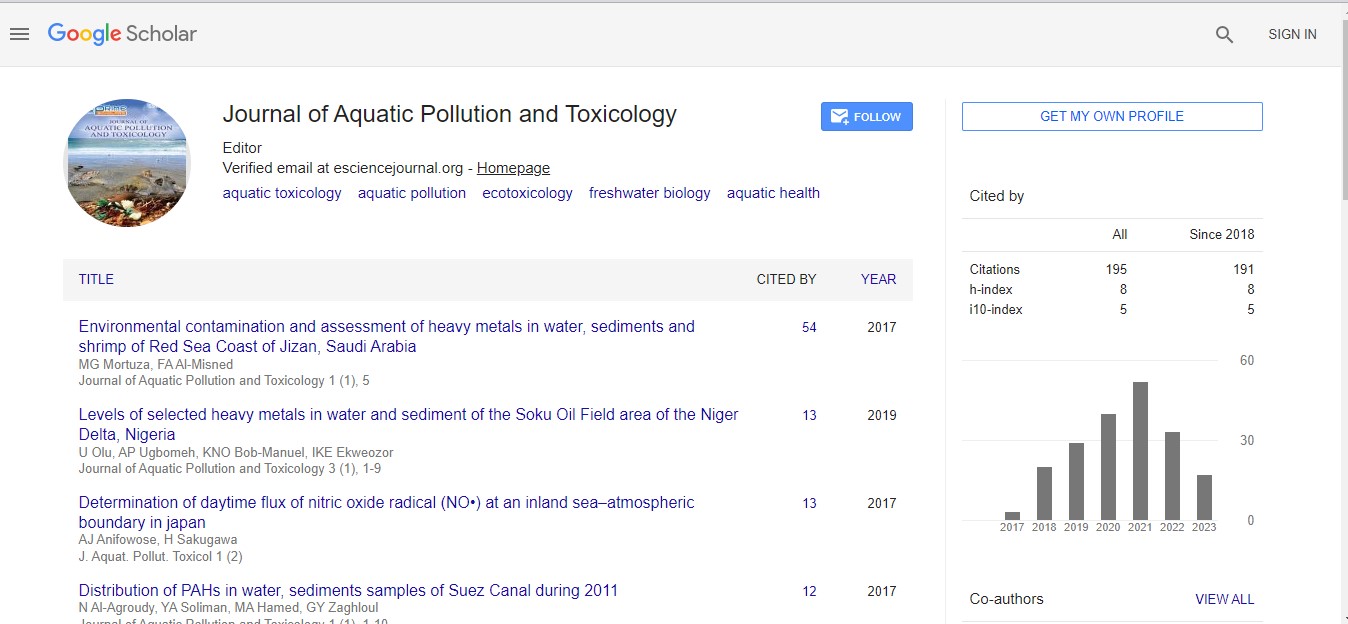Rachel Bezbaruah*
Department of Environmental Studies, Barkatullah University, Bhopal, India
- *Corresponding Author:
- Rachel Bezbaruah
Department of Environmental Studies
Barkatullah University, Bhopal, India
E-mail: Rachel_bezbaruah @gmail.com
Received: January 04, 2021; Accepted: January 17, 2021; Published: January 24, 2021
Citation: Bezbaruah R (2021) Water Pollution: Climatic Impact. J Aquat Pollut Toxicol. Vol. 5 No. 5: 2.
Water pollutants takes place whilst poisonous materials input water our bodies which includes lakes, rivers, oceans and so on, getting dissolved in them, mendacity suspended with inside the water or depositing at the bed. This degrades the first-class of water. Not handiest does this spell catastrophe for aquatic ecosystems, the pollution additionally seep via and attain the groundwater, which may grow to be in our families as infected water we use in our day by day activities, which includes drinking.
The essential water pollution encompass micro organism, viruses, parasites, fertilisers, pesticides, pharmaceutical products, nitrates, phosphates, plastics, faecal waste or even radioactive materials. These materials do now no longer constantly alternate the color of the water, that means that they're regularly invisible pollution. That's why small quantities of water and aquatic organisms are tested to decide water first-class.
Some pollution are objectionable due to the fact they overload the self-purification methods of the river. As rivers are regularly the uncooked water reassets for potable supplies, this will have dire consequences.
An instance of such pollutants is the release of home sewage effluent to rivers. In small portions it does no extreme damage and might certainly be beneficial, presenting a supply of natural carbon that gives vitamins to the animals with inside the river. But if inadequately handled or in immoderate portions, sewage effluent can severely harm the plant and animal existence of a river via way of means of lowering the oxygen content material of the water. In intense cases, wherein the oxygen content material is decreased to zero (or almost so), the river will help little or no existence, and turns into foul smelling and grossly offensive. A river in this type of nation is glaringly now no longer applicable as a water supply for potable supply.
The essential reassets of pollutants are all resulted from the disposal of chemical materials coming from medical, commercial and family waste, chaotic agricultural fertilizers disposal and unintentional oil spills that pollute the water to a massive extent. The severa infectious agents (micro organism, viruses, and parasites) that contaminate the water via sewage, human waste, and animal excreta radioactive waste that incorporates relatively poisonous substances which includes uranium, thorium, and radon. This waste is a primary water pollutant resulted from mining activities, electricity vegetation or herbal reassets the chemical materials that contaminate the water. These chemical compounds may be both natural - pesticides, plastic, oil, detergents, etc. - coming from home, commercial or agricultural waste, or inorganic - acids, metals, salts - home and commercial effluents.
Many physiological problems may also accompany crustaceans’ publicity to metals, and immediate metabolic activities’ alterations. Exposure of crustaceans to heavy metals may additionally bring about lack of urge for food for meals and finally frame weight loss. Continuous publicity may also lessen duplicate in adults in addition to bog down the boom larvae.
The following are typically used as signs of fecal infection in water: overall coliforms, Escherichia coli, fecal coliforms, fecal streptococci/enterococci, coliphage, and Clostridium perfringens. Coliforms are individuals of the own circle of relatives Enterobacteriaceae (they encompass E. coli). They are facultative anaerobic, Gram-negative, nonsporing, rod-fashioned micro organism that ferment lactose with fueloline formation inside 48 hours at 35°C.

